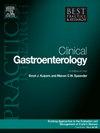How to measure quality in upper GI endoscopy
IF 4
3区 医学
Q2 GASTROENTEROLOGY & HEPATOLOGY
Best Practice & Research Clinical Gastroenterology
Pub Date : 2025-06-01
DOI:10.1016/j.bpg.2025.102025
引用次数: 0
Abstract
Esophagogastroduodenoscopy (EGD) is used in the diagnosis of neoplastic and non-neoplastic diseases. The rate of missed cancers remains high and exceeds 8 % for esophageal and gastric cancer. Several quality indicators have been identified to enhance the detection capability and decrease the neoplasia miss rate. Recently, the cleanliness of the mucosa has been identified as one such indicator. To achieve better visibility, premedication with N-acetylcysteine and simethicone should be considered. Advanced imaging modalities, such as virtual chromoendoscopy, may be helpful in the diagnosis of neoplasia and precancerous conditions, such as esophageal squamous cell carcinoma, Barrett's esophagus, and gastric dysplasia. Biopsy protocols, such as the MAPS and Seattle protocols, are another quality indicator, as they aim to identify patients at risk of gastric cancer and Barrett's esophagus-related dysplasia, respectively. Adequate inspection may be reflected in the procedure time or the endoscope withdrawal time. Several indicators have been proposed to monitor operator performance. The endoscopist's biopsy rate, composite detection rate, and Vater's papilla photodocumentation can be useful tools for auditing an endoscopist's performance and any link to neoplasia detection or missed cancers. In addition, monitoring patients' experiences using validated questionnaires is a performance measure of the endoscopy unit along with recording adverse events after therapeutic procedures.
如何测量上消化道内镜检查质量
食管胃十二指肠镜(EGD)用于诊断肿瘤和非肿瘤疾病。漏诊率仍然很高,食管癌和胃癌的漏诊率超过8%。确定了几个质量指标,以提高检测能力,降低肿瘤漏检率。最近,粘膜的清洁度已被确定为这样的指标之一。为了获得更好的可视性,应考虑在用药前使用n -乙酰半胱氨酸和西甲硅氧烷。先进的成像方式,如虚拟色内镜,可能有助于诊断肿瘤和癌前病变,如食管鳞状细胞癌、Barrett食管和胃发育不良。活检方案,如MAPS和西雅图方案,是另一个质量指标,因为它们旨在分别确定有胃癌和Barrett食管相关异常增生风险的患者。充分的检查可以反映在手术时间或取出内窥镜的时间。提出了几个指标来监测作业者的表现。内窥镜医师的活检率、复合检出率和Vater的乳头照相记录可以作为审核内窥镜医师工作表现和与肿瘤检测或漏诊癌症的任何联系的有用工具。此外,使用有效的问卷监测患者的经历是内窥镜检查单位的一项绩效衡量标准,同时记录治疗过程后的不良事件。
本文章由计算机程序翻译,如有差异,请以英文原文为准。
求助全文
约1分钟内获得全文
求助全文
来源期刊
CiteScore
5.50
自引率
0.00%
发文量
23
审稿时长
69 days
期刊介绍:
Each topic-based issue of Best Practice & Research Clinical Gastroenterology will provide a comprehensive review of current clinical practice and thinking within the specialty of gastroenterology.

 求助内容:
求助内容: 应助结果提醒方式:
应助结果提醒方式:


